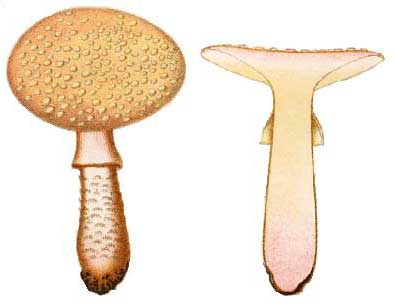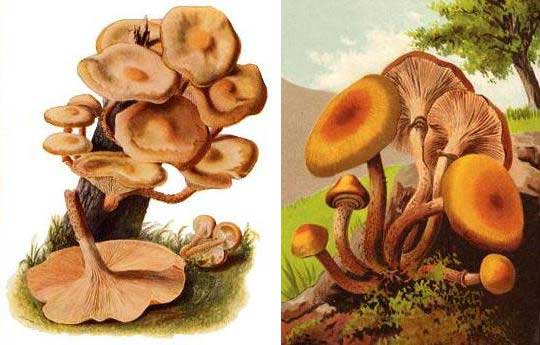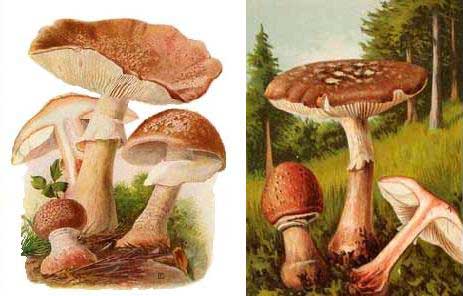Case StudiesCricked-neck mushroomsI've copied the following paintings of Amanita rubescens from the book Danmarks Spiselige Svampe, published in Copenhagen in 1876. On the left you can see the mushroom's surface features and on the right is a mushroom cut vertically to show the reddening of the exposed flesh.
The figure on the left makes me think of a person who has a cricked neck and is holding his head strongly to one side, for the stem is shown side-on but the cap is shown in surface view. Why? The artist would have wanted to show the features of the stem and the warty cap surface. By painting the mushroom in such an "unnatural" way the artist has achieved those aims very well in one simple painting. Now look at the following paintings of Pholiota mutabilis. The one on the left comes from E. Gramberg's Pilze der Heimat and the other is from W. Obermeyer's Pilz-Büchlein. The paintings are of roughly the same vintage, with both books having appeared in several editions early in the 20th century. In this species the mushrooms grow in clusters, with the stems all starting from the one point.
One immediately obvious difference is that the right hand painting is drawn in a natural setting, with the clustered mushrooms growing from the base of a stump in a mountain meadow. By contrast the cluster on the left, though growing from a stump has no scenic background and there is only a small patch of ground around the base of the stump. Moreover, one mature mushroom has been put upside-down on the ground and a triplet of immature mushrooms has been laid sideways. All in all the painting on the left is somewhat unnatural. Yet, how natural is the painting on the right? It shows four mature, open caps and three still to open. The mature caps have two markedly different orientations. Two caps are virtually vertical, so giving us a clear view of the gills, while the other two are angled less steeply but in the opposite direction so we get a good view of the cap surfaces. In essence those two mushrooms with the vertical caps are much like the "cricked-neck" mushroom at the start of this page. The essential function of a mushroom cap is to support the gills in such a way as to maximise spore dispersal. Put simply, a stem is programmed to grow vertically and a cap is programmed to develop horizontally. Obstructions can cause deviations but the vertical and horizontal tendencies are always there. A horizontal cap helps ensure that the gills are held vertically with an unobstructed vertical pathway between gill surfaces and the outside air below the cap. The spores released from the basidia that line the gills would fall clear of the cap and then be carried away by the slightest of breezes. A horizontal cap also protects the gills from impact damage (for example by falling raindrops or wind-blown soil grains) and helps stop the gills drying out by keeping them away from direct exposure to wind or sun. The gills on the vertical caps of the right hand painting certainly are exposed to the drying effects of wind and sun. In addition a great many of the spores released from the basidia would simply fall back onto the same or other gills. It is a very strange way for the mushrooms to grow. In species that produce mushrooms in dense clusters the mass of abutting caps can cause distortions in stem growth and cap shape or orientation. However, in the group shown here there is no such congestion and there is ample room to accommodate the four open caps horizontally. I imagine that the artist has shown the four mature caps at different angles in order to show clearly both the undersides and the upper surfaces of the caps. By contrast the artist of the left hand painting has chosen to show the underside of a mature cap in a different way. It's not a case of one painting being wrong and the other right. Each of the books is a guide book to fungi, aiming to present all the visual evidence needed to recognize any particular species. The artists have simply gone about that task in different ways. Below is another painting from Obermeyer's book, which he'd captioned Boletus elegans, but the species is now known as Suillus grevillei. These three boletes are growing separately, without the stem bases in contact. It may be that some local conditions did cause the three boletes to develop in exactly the way shown. However, there seems to be nothing stopping all three stems growing vertically, rather than having the two immature boletes lean one way and the mature bolete lean the opposite way. By showing the boletes leaning in different directions the artist has given us clear views of the cap surface and of the partial membrane that covers the pore layer in an immature Suillus grevillei and which tears as the cap expands.
Cricked-neck and leaning mushrooms appeared in paintings before the 20th century and still appear today. They are some of the subtle tricks a good artist can use to give considerable detail about a species, if the aim is to avoid showing an obviously disturbed scene. The point here is not to criticize the painters, indeed there is a role for such artful presentation of a species' characteristics. My aim is simply to make you think of what you're seeing the next time you look at a painting of mushrooms in a natural setting. This raises the question: Can you get cricked-neck mushrooms naturally? Certainly, for example a stem growing out from a vertical soil bank or from the lower side of a fallen tree trunk may first be forced to grow horizontally to clear any overhead obstructions. Once clear the stems can then change to vertical growth so as to eventually position the cap horizontally. In such circumstances you'd see a stem with a definite right-angle bend to it. It can also happen in species that grow in dense clusters and where the stems all start from the same point. As they grow the stems will spread out. The central stems will grow vertically or close to vertically while those further away from the centre will have their initial growth closer to horizontal until they are clear of the obstruction caused by the central mushrooms. The following stylized diagram shows what happens - and note the horizontal caps.
Just for interest, here are the paintings of Amanita rubescens from the Gramberg and Obermeyer books, left and right respectively. It's the same species that this page started with. The Obermeyer picture is exactly how it appears in the book. I haven't cropped it on the right.
|
![An Australian Government Initiative [logo]](/images/austgovt_brown_90px.gif)






